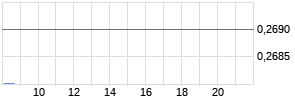
La India Project Soil Geochemistry Survey Completed Indicating Major Gold District
PR Newswire
LONDON, August 1, 2017
LONDON, August 1, 2017 /PRNewswire/ --
Condor (AIM: CNR), is pleased to announce the completion of a detailed soil geochemistry survey (soil survey) over the entire 313 km² La India Project, Nicaragua. Samples were collected along 100 m, 200 m or 400 m spaced, north-south oriented, lines and at intervals varying from 50 m to 400 m along each line over a 3 year period (see Figure 1 below). The soil survey is a key component of a multi-disciplined approach, including geological mapping and airborne geophysics, to prove a major gold district at the Project, which currently hosts a high grade mineral resource of 18.08 M tonnes at 4.0 g/t for 2.31 M oz gold.
Highlights
- Soil survey completed over entire 313 km² La India Project
- Soil results map major geological features, including two major feeder zones that run across the tenement in a northwesterly direction, the La India and Andrea Corridors, an east-west linking structure, and a major eroded caldera.
- Complex structural geological setting is indicative of a major gold district
- Soil results also identify preferentially mineralized targets within these features
- 142.4 g/t gold rock chip sample identified approximately 30 m along strike from a 53.9 g/t gold rock chip on the Los Limones prospect at the northern end of a 12.5 km mineralised corridor, 9 km north of the main La India open pit reserve.
Mark Child CEO comments:
"The completion of a soil geochemistry survey over the entire 313 km² La India Project is a major milestone in proving La India Project hosts a major Gold District. It forms part of a multi-disciplined approach of generating new targets utilising the knowledge from over 70,000 m drilling and 28,000 m trenching to date in the core areas, while importantly building on the airborne geophysics survey of 2014, the detailed structure geological model of 2015, and on-going traditional geological mapping and drilling programme.
Major gold districts tend to be discovered in complex structural settings. The soil geochemistry survey has identified two major, mineralised basement feeder zones running NW to SE through the Project, cut by the Highway Fault, which down-throws the southeastern part of the District, which is in turn cut by an east-west link structure, to produce such a complex structural setting. Condor's multi-disciplined approach and a boots-on-the-ground philosophy, is generating several new drill targets and will eventually contribute to the global gold resource."
Background
A total of 13,194 samples were analysed during 2015, 2016 and 2017. They were collected along north-south lines at 100 to 400 m spacing and at intervals of 50 to 400 m. The survey covers both 'virgin' territory, with no mapped epithermal veins, at the broader spacing; and areas of known mineralization, such as the La India, America and Mestiza Vein Sets at the tighter spacing. La India Project has approximately 105 km strike length of veins, of which about 55 km have been trenched or mapped in any detail; only 13.2 km have been drill tested. The intention was to provide baseline data that can be used to generate new targets. A detailed report, describing methods, laboratory techniques and results, is available on request. Email: information@condorgold.com .
Unlike most low sulphidation epithermal gold veins, those at La India Project tend to have very narrow, and weak, hydrothermal alteration haloes. This is confirmed by recent SpecTerra (Short Wave Infrared) work on drill core, which showed limited hydrothermal clay development. The veins are also very low in sulphides (e.g., pyrite and arsenopyrite) and have correspondingly low levels of associated metals.
Interpretation
The above weak alteration and low sulphide content of the epithermal system is reflected in narrow and subtle soil geochemical anomalies, even around high-grade gold veins, such as La India vein. Like the veins, the soils have very low contents of base metals (e.g., copper, zinc, lead) and associated pathfinder elements (e.g., mercury, arsenic). Consequently, the best pathfinder for gold is gold, although low level anomalism in the traditional pathfinder elements (e.g., silver, arsenic, antimony, tellurium and thallium) does define important targets.
An analysis of the entire dataset shows two main corridors of anomalous geochemistry, referred to as La India Corridor and Andrea Corridor (Figure 1). These extend for over twenty kilometres and coincide with major basement structures seen in the airborne magnetics dataset. They probably represent fundamental basement structures, each acting as a feeder for ascending hydrothermal fluids.
The known veins occur along these corridors, but are clearly shown to have better continuity than is apparent from geological mapping. For example, the Andrea vein has much greater continuity than previously thought, extending for at least 4 km.
The corridors converge in the far northwest in an area with significant soil anomalies of gold, thallium and silver. This coincides with a "hinge zone" seen in the airborne magnetics data. It is near Los Limones, where rock sampling has reported veins with including two samples, 30m apart of 53.9 g/t gold and 142.4 g/t gold (Figure 3). This area is earmarked for early ground checking, as intersection zones are generally prospective target areas.
The Highway Fault, a northeast striking post-mineral fault (Figures 1 and 2), drops down the entire epithermal system to the southeast. This is reflected in weaker anomalies and a dominance of high level pathfinder elements. It is believed that areas southeast of the Highway Fault contain concealed targets and that the down-thrown block preserves the top of the system at Cacao, which includes sinter and phreatic breccias, indicating the paleosurface. There is also the possibility that the strike extension to La India vein continues to the south, but is similarly down-thrown.
High level pathfinder elements also map a linking structure, coinciding with Cacao and Santa Barbara, both targeted for additional drilling (Figure 1).
Figure 1: Demonstrates Two Major Basement Feeder Zones.
https://www.juniorminingnetwork.com/images/news/August_2017/Condor_Gold_8-1-2017_1.png
Note: Figure 1 above: Gridded plot of antimony in soils, with gridlines at 10 km intervals
The data also support the interpretation of an eroded caldera to the west near the town of Santa Rosa De Penon. This is mapped by arcuate anomalies of arsenic, antimony, mercury and bismuth. There are two main anomalies of interest that will require follow up. The first is a broad, 3 x 5 km wide, zone of elevated arsenic, antimony, thallium, tungsten, lead and molybdenum on the western margin of the caldera where La India Corridor intersects the caldera margin. The second is a more focussed, 1.5 x 3 km wide, zone of elevated arsenic, thallium, molybdenum, antimony with a bismuth halo within the caldera in an area covered by young, intra-caldera ignimbrite. Both anomalies merit further mapping.
One of the most useful tools for exploration of epithermal vein systems is commonly the gold:silver ratio. High gold relative to silver suggests hydrothermal upflow zones, generally with better gold grades. To test this concept, soil samples below 5 ppb gold were removed and the remaining 3,547 samples gridded. Figure 2 clearly shows elevated values at La India, the central part of America/Guapinol, and 'Big Bend' at Mestiza (currently being drilled). There are also encouraging values at Santa Barbara and West of Los Limones.
Figure 2 Symbol plot of gold:silver ratio, with gridlines at 10 km intervals.
https://www.juniorminingnetwork.com/images/news/August_2017/Condor_Gold_8-1-2017_2.png
Condor geologists are continuing to work with the soil data and analyse it in more detail with the other available datasets, including airborne magnetics and radiometrics, and geological mapping, to generate more targets. Follow up mapping is focussing on the initial inventory of targets that reflect the high grade, narrow vein mineralisation that comprises the current resource base. This includes anomalies west of Los Limones, Santa Barbara and southeast of La India.
142.4 g/t Gold and 53.9 g/t Gold Rock Chip Samples 12 km from Open Pit Reserve
Los Limones prospect, including two rock chip samples 30 m apart of 53.9 g/t gold and 142.4 g/t gold was identified during the soil survey. The rock chips are located in a remote area in the far north of the concession package, approximately 12 km from the nearest mineral resource at Cristalitio-Tatescame and the Highway Fault. Condor is applying for a drilling permit and plans detailed geological mapping of Los Limones prospect in 2017 (See Figure 3 in link below)
Figure 3
https://www.juniorminingnetwork.com/images/news/August_2017/Condor_Gold_8-1-2017_3.png
Competent Person's Declaration
The information in this announcement that relates to the mineral potential, geology, exploration results and database is based on information compiled, and reviewed, by Mr Peter Flindell, Member of the Australian Institute of Geoscientists, Member of the Australasian Institute of Mining and Metallurgy and Member of the Society of Economic Geologists. Mr Flindell is a geologist with over thirty years of experience in the exploration of precious metal mineral resources. Mr Flindell is a non-executive director on the Board of Condor Gold plc who also provides technical leadership to the technical team in Nicaragua and has considerable experience in epithermal mineralization, the type of deposit under consideration, and sufficient experience in the type of activity that he is undertaking to qualify as a 'Competent Person' as defined in the June 2009 Edition of the AIM Note for Mining and Oil & Gas Companies. Mr Flindell consents to the inclusion in this regulatory announcement of technical disclosure, which he has read and approved, in the form and context in which it appears and confirms that this information is accurate and not false or misleading.
Technical Glossary
The laboratory test conducted to determine the proportion of
a mineral within a rock or other material. Usually reported
as parts per million which is equivalent to grams of the
Assay mineral (i.e. gold) per tonne of rock
In structural geology, en echelon veins are structures
within rock caused by tension fractures that are parallel to
the major stress orientation. They appear as sets of short,
parallel, planar, mineral-filled lenses within a body of
En echelon rock.
The study of the elements and their interaction as minerals
Geochemistry to makeup rocks and soils
The measurement and interpretation of the earth's physical
parameters using non-invasive methods such as measuring the
gravity, magnetic susceptibility, electrical conductivity,
Geophysics seismic response and natural radioactive emissions.
Hot water circulation often caused by heating of groundwater
by near surface magmas and often occurring in association
with volcanic activity. Hydrothermal waters can contain
Hydrothermal significant concentrations of dissolved minerals.
The measurement of the magnetic properties of the earth
surface as controlled by the concentration and distribution
of magnetic minerals, particularly magnetite, in the rock.
Rocks containing higher levels of iron, such as mafic
igneous rocks or some sedimentary rocks will have a higher
Magnetic magnetic susceptibility than felsic igneous rocks,
(aeromagnetic) siliciclastic and carbonate sediments and their metamorphic
survey derivatives..
A concentration or occurrence of material of economic
interest in or on the Earth's crust in such a form, quality,
and quantity that there are reasonable and realistic
prospects for eventual economic extraction. The location,
quantity, grade, continuity and other geological
characteristics of a Mineral Resource are known, estimated
from specific geological knowledge, or interpreted from a
Mineral Resource well constrained and portrayed geological model
The economically mineable part of a Measured and/or
Indicated Mineral Resource. It includes diluting materials
and allowances for losses, which may occur when the material
is mined. Appropriate assessments and studies have been
carried out, and include consideration of and modification
by realistically assumed mining, metallurgical, economic,
marketing, legal, environmental, social and governmental
factors. These assessments demonstrate at the time of
reporting that extraction could reasonably be justified. Ore
Reserves are sub-divided in order of increasing confidence
Mineral Reserve into Probable Ore Reserves and Proved Ore Reserves.
Also known as gamma ray spectrometry, is the measure of
natural radiation on the top 30-45cm of the earth's surface.
The abundance of the three naturally occurring radioactive
elements, potassium (K), thorium (Th) and uranium (U), is
proportional to the abundance of minerals containing those
elements. This information can be used in mapping the
surface geology including the definition of areas of
Radiometric potassium enrichment related to hydrothermal alteration.
A sample of rock collected for analysis, from one or several
close spaced sample points at a location. Unless otherwise
stated, this type of sample is not representative of the
variation in grade across the width of an ore or mineralised
body and the assay results cannot be used in a Mineral
Rock chip Resource Estimation
Multiple connected veins with more than one orientation,
typically consisting of millimetre to centimetre thick
Stockwork fracture-fill veins and veinlets.
The longest horizontal dimension of an ore body or zone of
Strike length mineralisation.
A sheet-like body of crystallised minerals within a rock,
generally forming in a discontinuity or crack between two
rock masses. Economic concentrations of gold are often
Vein contained within vein minerals.
About Condor Gold plc:
Condor Gold plc was admitted to AIM on 31st May 2006. The Company is a gold exploration and development company with a focus on Central America.
Condor completed a Pre-Feasibility Study (PFS) and two Preliminary Economic Assessments (PEA) on La India Project in Nicaragua in December 2014. The PFS details an open pit gold mineral reserve of 6.9 Mt at 3.0 g/t gold for 675,000 oz gold producing 80,000 oz gold p.a. for 7 years. The PEA for the open pit only scenario details 100,000 oz gold production p.a. for 8 years whereas the PEA for a combination of open pit and underground details 140,000 oz gold production p.a. for 8 years. La India Project contains a total attributable mineral resource of 18.08 Mt at 4.0 g/t for 2.31 M oz gold and 2.68 M oz silver at 6.2 g/t to the CIM Code.
In El Salvador, Condor has an attributable 1,004,000 oz gold equivalent at 2.6 g/t JORC compliant resource. The resource calculations are compiled by independent geologists SRK Consulting (UK) Limited for Nicaragua and Ravensgate and Geosure for El Salvador.
For further information please visit www.condorgold.com or contact:
Condor Gold plc
Mark Child, Executive Chairman and CEO
+44-(0)-20-7493-2784
Beaumont Cornish Limited
Roland Cornish and James Biddle
+44-(0)-20-7628-3396
Numis Securities Limited
John Prior and James Black
+44-(0)-20-7260-1000
Farm Street Media
Simon Robinson
+44-(0)-7593-340107
Disclaimer
Neither the contents of the Company's website nor the contents of any website accessible from hyperlinks on the Company's website (or any other website) is incorporated into, or forms part of, this announcement.
SOURCE Condor Gold plc

Mehr Nachrichten zur Condor Gold Plc. Aktie kostenlos abonnieren
(Mit der Bestellung akzeptierst du die Datenschutzhinweise)

Hinweis: ARIVA.DE veröffentlicht in dieser Rubrik Analysen, Kolumnen und Nachrichten aus verschiedenen Quellen. Die ARIVA.DE AG ist nicht verantwortlich für Inhalte, die erkennbar von Dritten in den „News“-Bereich dieser Webseite eingestellt worden sind, und macht sich diese nicht zu Eigen. Diese Inhalte sind insbesondere durch eine entsprechende „von“-Kennzeichnung unterhalb der Artikelüberschrift und/oder durch den Link „Um den vollständigen Artikel zu lesen, klicken Sie bitte hier.“ erkennbar; verantwortlich für diese Inhalte ist allein der genannte Dritte.




